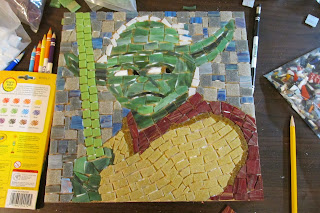First I did a sketch.
 |
| Yoda Sketch |
 |
| Glass Layout |
Next I glued Yoda.
And then I completed the background.
And then I completed Yoda with a gray grout.
 |
| Yoda Final Side |
 |
| Yoda Final |
Here is my client with the finished piece.
Colors used on this project
Eyes - White, Metallic light Brown, Black
Light Saber - Kiwi Eco (Maryland Mosaics)
Skin - Green Stained Glass
Shirt - Tiger's Eye, Sand, Oak
Backgound - Mix Mushroom, Basalt (B39), Metalic Blues, Gray
For those of you who are not familiar with Yoda. (Source: Wikipedia)
Colors used on this project
Eyes - White, Metallic light Brown, Black
Light Saber - Kiwi Eco (Maryland Mosaics)
Skin - Green Stained Glass
Shirt - Tiger's Eye, Sand, Oak
Backgound - Mix Mushroom, Basalt (B39), Metalic Blues, Gray
For those of you who are not familiar with Yoda. (Source: Wikipedia)
Grand Jedi Master Yoda is among the oldest and most powerful known Jedi Masters in the Star Wars universe. Series creator George Lucas opted to have many details of the character's life history remain unknown. Yoda's race and home world have not been named in any media, canonical or otherwise, and he is merely said to be of a "species unknown" by the Star Wars Databank. Yoda's speech syntax has been analyzed and discussed by academic syntacticians, who found it somewhat inconsistent, but could extrapolate that it has object–subject–verb word order.
The films and Expanded Universe reveal that during 800 years, he had a hand in training almost every Jedi, including many of the most powerful Jedi such as Count Dooku, who is identified in Attack of the Clones as Yoda's old Padawan Learner; Mace Windu; Obi-Wan Kenobi (partially, before Qui-Gon Jinn takes over as Obi-Wan's master); Ki-Adi-Mundi, Kit Fisto and eventually Luke Skywalker. During the animated series Star Wars: Clone Wars, set between Attack of the Clones and Revenge of the Sith, he mentions that he trained another one of the leaders on the Jedi Council, Master Oppo Rancisis. In the Star Wars prequels, it is shown that he instructs several younglings in the Jedi Temple before they are assigned to a master. This was displayed in a scene in Attack of the Clones.


















































.jpg)

